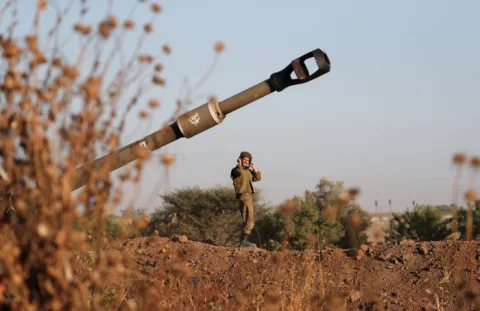Israel said to have accounted for 69% of Azerbaijan's arms imports in 2020
The annual report of the SIPRI institute sheds light on the export statistics of the world's largest arms exporting countries. The US increased its share at the expense of Russia and China. Germany and France also took bigger pieces of the pie
Dan Arkin
|
21/03/2021
Israel's arms exports made up 3.0% of the overall arms sales worldwide in the years 2016-2020 and were 59% higher compared to those in the years 2011-2015. Israel accounted for 69% of the arms imports of Azerbaijan. Israeli companies are currently considering arms sales to Middle Eastern countries that until now had been closed to them, according to Sweden's Stockholm International Peace Research Institute (SIPRI) whose annual report was published this week.
The US expanded its share of global arms sales from 32% in 2011-2015 to 37% in 2016-2020, and is still the largest exporter of weapons. The US supplied weapons to 96 countries, more than any other supplier, in the years 2016-2020.
Almost half (47%) of the US arms transfers were to the Middle East. Saudi Arabia by itself made up 24% of American arms exports. The 15% growth in American arms exports between the years 2011-15 and 2016-2020 further widened the gap between the US and the second-largest arms manufacturer, Russia.
The third and fourth-largest arms exporters also experienced significant growth between the years 2011-2015 and 2016-2020. France expanded its exports of major arms by 44% and was responsible for 8.2% of global arms exports in the years 2016-2020. India, Egypt and Qatar together received 59% of the French arms exports.
Germany increased its exports of major arms between 2011-2015 and 2016-2020, accounting for 5.5% of the global total. The leading markets for German arms exports were South Korea, Algeria and Egypt.
Russia and China saw their arms exports fall. Arms exports by Russia, which accounted for 20% of all major arms exports in 2016-2020, dropped by 22% (to a level similar to that of 2006-10). The lion's share of the decrease, about 90%, was from a drop of 53% in its arms exports to India.
The exports of China, the world's fifth-largest arms exporter in the years 2016-2020, decreased by 7.8% between 2011-15 and 2016-20. Chinese arms exports made up 5.2% of the overall arms exports in the years 2016-20. Pakistan, Bangladesh and Algeria were the biggest importers of Chinese arms.
The Defense News website reported that despite the growth in arms exports, SIPRI said that there was a certain slowdown in the years covered by the report. According to Pieter Wezeman, a senior researcher for the Swedish institute, it is possible that the COVID-19 pandemic had an influence on arms export policy, and many countries are reassessing their military acquisitions due to difficulties from the pandemic.
The annual report of the SIPRI institute sheds light on the export statistics of the world's largest arms exporting countries. The US increased its share at the expense of Russia and China. Germany and France also took bigger pieces of the pie
Israel's arms exports made up 3.0% of the overall arms sales worldwide in the years 2016-2020 and were 59% higher compared to those in the years 2011-2015. Israel accounted for 69% of the arms imports of Azerbaijan. Israeli companies are currently considering arms sales to Middle Eastern countries that until now had been closed to them, according to Sweden's Stockholm International Peace Research Institute (SIPRI) whose annual report was published this week.
The US expanded its share of global arms sales from 32% in 2011-2015 to 37% in 2016-2020, and is still the largest exporter of weapons. The US supplied weapons to 96 countries, more than any other supplier, in the years 2016-2020.
Almost half (47%) of the US arms transfers were to the Middle East. Saudi Arabia by itself made up 24% of American arms exports. The 15% growth in American arms exports between the years 2011-15 and 2016-2020 further widened the gap between the US and the second-largest arms manufacturer, Russia.
The third and fourth-largest arms exporters also experienced significant growth between the years 2011-2015 and 2016-2020. France expanded its exports of major arms by 44% and was responsible for 8.2% of global arms exports in the years 2016-2020. India, Egypt and Qatar together received 59% of the French arms exports.
Germany increased its exports of major arms between 2011-2015 and 2016-2020, accounting for 5.5% of the global total. The leading markets for German arms exports were South Korea, Algeria and Egypt.
Russia and China saw their arms exports fall. Arms exports by Russia, which accounted for 20% of all major arms exports in 2016-2020, dropped by 22% (to a level similar to that of 2006-10). The lion's share of the decrease, about 90%, was from a drop of 53% in its arms exports to India.
The exports of China, the world's fifth-largest arms exporter in the years 2016-2020, decreased by 7.8% between 2011-15 and 2016-20. Chinese arms exports made up 5.2% of the overall arms exports in the years 2016-20. Pakistan, Bangladesh and Algeria were the biggest importers of Chinese arms.
The Defense News website reported that despite the growth in arms exports, SIPRI said that there was a certain slowdown in the years covered by the report. According to Pieter Wezeman, a senior researcher for the Swedish institute, it is possible that the COVID-19 pandemic had an influence on arms export policy, and many countries are reassessing their military acquisitions due to difficulties from the pandemic.



